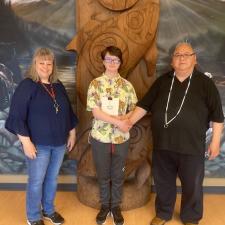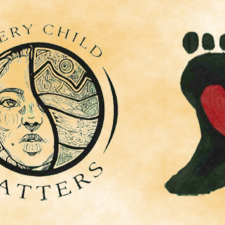
Orange Shirt Day art contest supports young Indigenous artists
Phyllis's story inspired Orange Shirt Day in 2013, which aims to educate people on residential schools in Canada. The day honours and remembers the experiences and loss of First Nation, Inuit and Métis children who were stolen from their families and placed in these schools. Every September 30th, individuals across Canada wear orange on Orange Shirt Day to visually represent this important day of remembrance.
Earlier this year, the Abbotsford School District invited Indigenous students in grades K - 12 to submit a design for consideration for orange shirts that would be made available to school district staff and students through an Orange Shirt Day art contest. Led by Brian Point, an Indigenous Support Worker with the Indigenous Education department, the contest saw over 100 unique and creative entries submitted. In May 2022, the entries were finalized into two images, which are seen on orange shirts throughout the district. The awarded young artists also received a gift as a token of appreciation.
The main design was created by Jaye Kovacs, a grade 12 student at Abbotsford Senior Secondary. Jaye is a Métis, transgender artist, and illustrator. He loves telling stories and representing people and culture through his art. As an Indigenous person, it is important to him to help empower voices and keep traditions alive.
"When I was creating the artwork, I knew I wanted to do it in an Indigenous style," explained Jaye. "I wanted to show pride in the beauty of Indigenous artwork. The primary theme is Indigenous people's connections: of the past and present, and between people and nature. The landscape is open and clear, to show our relationship with nature, how our ancestors were free on the land they lived experience in, and how we are trying to reconnect with this past as Indigenous people in the modern-day. It also symbolizes coming into your identity as an Indigenous person; whether as someone in the modern-day who had not had a chance to learn before or in a traditional Indigenous coming of age experience. Finally, the circle and the yin yang shape symbolize how the past and present are all connected, and the balance, flow, and understanding we need to live in harmony and achieve reconciliation."
A secondary image, the design of a Sasquatch footprint, was created by Keagan Emerson, a grade 6 student. Keagan is a Métis student at W.A. Fraser Middle School.
"The footprint image that I chose has many layers of meaning for me," said Keagan. "When I was in grade 5, I learned about the Indigenous teaching of honesty. The 'Sabe' or Sasquatch represents honesty. Most of the time, I try to be honest because this is important in my family. The Sasquatch is also a very mysterious creature, a trait I connect with. I chose to use the footprint image because it is the only evidence we have to represent a Sabe sighting. I paired this symbol with a message of love. When people feel loved, they are less sad and lonely. I imagine Sabe is lonely because he is always hiding from people and does not have anyone else. The message of love and honesty is also for those families who lost children to residential schools. Honesty, like that of the Sasquatch, is needed to promote healing and love moving forward."
Of the profits collected from the orange shirt day sales, 50% of sales will be donated to Phyllis Webstad Orange Shirt Society, and the remaining allotment will be designated to a newly formed local society of Elders who attended St. Mary's Residential School in Mission, BC. Currently, orders are closed, but a small number of adult sizes may still be available for purchase for $21 through the Indigenous Education department.


